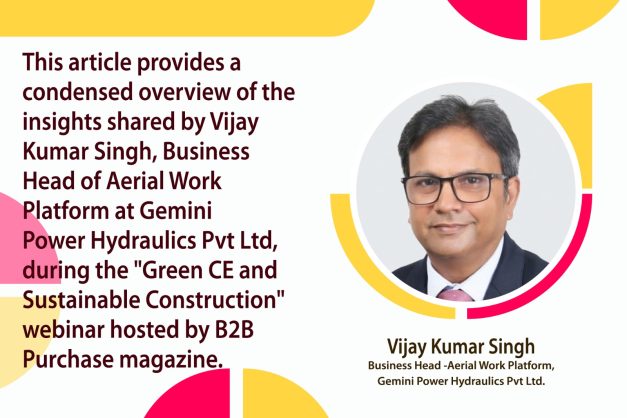This article provides a condensed overview of the insights shared by Vijay Kumar Singh, Business Head of Aerial Work Platform at Gemini Power Hydraulics Pvt Ltd, during the “Green CE and Sustainable Construction” webinar hosted by B2B Purchase magazine.
This article provides a condensed overview of the insights shared by Vijay Kumar Singh, Business Head of Aerial Work Platform at Gemini Power Hydraulics Pvt Ltd, during the “Green CE and Sustainable Construction” webinar hosted by B2B Purchase magazine.
This visionary managing director questioned the existing status quo at the helm of one of the nation’s most advanced cement plants. He asked us to consider the legacy we leave for coming generations. This turning point spurred me to write about our experience, hoping that other professionals would be motivated to explore the relationship between technology innovation and environmental responsibility.
The construction equipment paradigm
Looking at the state of construction machinery today, we can see that many of these enormous machines are now powered by electricity. But the emphasis here is on the smart integration of battery-powered solutions rather than a whole rebuild, especially regarding access machinery. The goal is to break away from the constraints of gasoline-powered or internal combustion engines.
Global emission realities
Our investigation comes to a crucial pause when we encounter the problematic trio of emissions: carbon dioxide, nitrogen oxide, and carbon monoxide. There has never been a greater urgent need to fight these environmental enemies since they pose a serious threat. Looking at India, we take comfort in their per capita emissions being the lowest. This solace, however, is fleeting because the growth rate during the previous 50 years a tenfold increase raises red flags. It is the duty not only of our country but also of industry forums and apex bodies to work together to jointly map out a path that preserves the environment for future generations.
The 25 percent dilemma
Examining the numbers in more detail, we find that power plants account for around 25% of carbon emissions, autos for about 25 percent, and other sectors for the other 25%. This leads to a global reflection on the need for “green machines” in the building industry. Their energy-saving qualities, noiseless operation, zero emissions, and affordability are not only required by law but also vital to their strategic business operations.
Powering the giants with green tech
In the construction equipment industry, there is a persistent misconception that some powerful machines, especially those designed for tough terrain, must be battery-operated. It’s time to refute this assumption. Producers and consumers should know that even the most potent equipment can easily convert to battery power. This not only simplifies processes but also eliminates the requirement for several devices designed for outdoor and indoor use.
Economics of going green
Beyond their positive effects on the environment, adopting battery- operated devices has significant financial advantages. With a 55 percent lower operating cost than their diesel counterparts, the economics are clear to see. This financial benefit results from lower fuel use, adding substantial savings throughout the machine. The lower maintenance requirements also enhance the overall economic attractiveness due to innovations like AC motors and the elimination of hoses.
Green zones and carbon footprints
Low-emission zones, already a reality in Sweden and London, are reshaping the landscape in this future vision. India may soon adopt this idea of limiting emissions-producing vehicles. At the same time, ‘green- rated’ construction sites which have zero emissions and pollution are becoming increasingly well-known worldwide. Businesses are actively reducing their carbon footprints rather than just acknowledging them. India is positioned to take advantage of the impending tsunami of awareness.
The industry has a never-before- seen chance to drive change due to the convergence of economic gains, environmental responsibility, and technology advancements. Now, the question is not if we can afford to make this change, but rather, can we afford not to?
Cookie Consent
We use cookies to personalize your experience. By continuing to visit this website you agree to our Terms & Conditions, Privacy Policy and Cookie Policy.





















